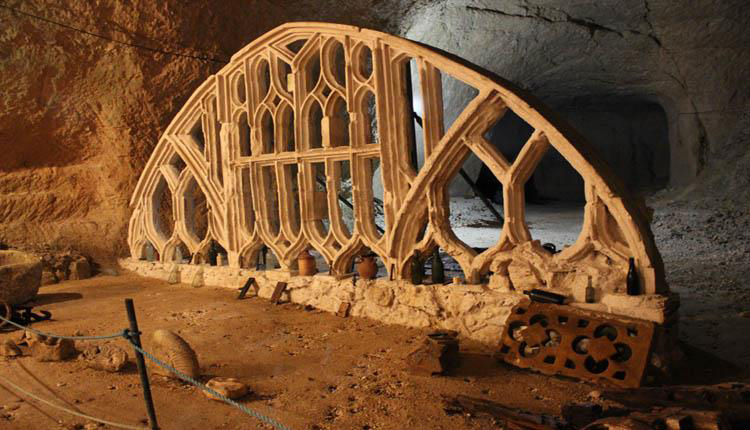Temporarily shut by Coronavirus pandemic – join us when we open
If curses could kill the coronavirus would be long dead. I’ve contacted an ancient Irish poet friend and asked him to get out his great book of Ulster Curses, aim a good one at coronavirus and let fly. But so far, like President Trump’s chloroquine and Dettol, no luck.
In the meantime our doors are temporarily shut but not our curiosity.
Beer Quarry Caves are many things. They are the longest worked limestone quarry-mine in Great Britain. The quarry was first opened by the Roman’s, probably using local slave labour, sometime soon after the 2nd Roman invasion of Britain in 43 AD, perhaps as early as 50 AD. Almost 2000 years later the caves helped see us through World War 11 as an ammo store and mushroom source for hungry Londoners. In between those two events the entire story of modern English and British History unfolded around the caves.
In 1348 the caves were open when the Black Death came to England, starting at Weymouth in next door Dorset, in June that year. The plague took two forms, bubonic up to the Autumn of 1348, and then, a bit like coronavirus now, a pneumonic form . The plague killed between 40% and 60% of the population of England and kept returning for years, in the form of new outbreaks, something the current government might take note of. With a dearth of labour as workers died from the plague, wages rose partly leading to the Peasants revolt in 1381, against taxes to pay for the plague effects, and serfdom, another consequence our present government might note carefully.
Going back a bit further, Beer Quarry Caves were open when about 60 different recorded pandemics struck England between 664 AD and 1348 AD. These pandemics varied but a regular cause was war or invasion. Corpses were left to rot where they fell and disease soon followed. War as the World at War series for WW2 recently showed, still killed vast numbers of people less than 75 years ago, many from typhoid and indeed bubonic plague, again. As part of our new researches we will be trying to find out how those running Beer Quarry caves dealt with those events during those long years between 664 AD and 1348 AD.
But the caves have a much older and more significant record in their walls and underfoot. The limestone in the caves was laid down between 200 million and 300 million years ago. About 250 million years ago the great Permian extinction occurred, killing 96% of all life on the planet, and 70% of all life in our young earth’s oceans. There have been 5 great extinctions since the first appearance of life on earth, between 600 million and 900 million years ago, of which the Permian was the most devastating. Scientists do not agree on the cause of the Permian extinction but a meteor collision is one suggestion. The geologist Professor Ian West has pointed out that the presence of chromite and serpentine in the limestone in the caves “is quite peculiar”. He writes that “Another possibility, much less likely, is that the chromite and serpentine grains are of meteorite origin” but he then points out that, “ Material believed to be ejecta from a meteorite impact event has been found at a coastal site in Portugal Monteiro et al.(1988), Thus it is almost exactly the same age as the Beer Stone”. At least 2 others of the 5 extinctions may have left their mark on the caves too and we are now in search of that record and ways to display it.
Flint has always been an important issue at the caves. John Scott FRSA, FRGS, who saved the caves from demolition in the 1980’s and created our tour company, believed that flint from the quarry site may have been found at both Stonehenge and at Carn Brae in Cornwall. We are currently investigating the site and the area for evidence of a prehistoric flint ‘factory’.
Its easy to forget that for 90% of the life span of homo sapiens the only tool humans had, for hunting and for lighting fires, was flint.
About 6 miles from the caves, at Broom on the river Axe north of Axminster is probably the most important historic ancient tool find in the South West. Workmen digging a cutting in the 1870’s discovered a huge trove of (chert) flint axe heads and tools, 2,300 of which survive in museum collections. Carbon dating puts the age of the tools at about 350000 BC, long before homo sapiens turned up in Britain. The huge Ancient History of Britain (AHOB) project missed Broom, possibly because no human bones had been found there. But AHOB also missed the last formal evidence of Neanderthal mankind in the west of England. We are currently investigating the links to the flint at Beer.
But perhaps our most interesting find is what we are calling ‘the aquifer next door’. Water supplies in most places come from reservoirs, lakes and rivers. In West Dorset and East Devon it comes from an ancient aquifer, dated to between the Triassic and Permian period by the British Geological Survey. That coincides with the formation of the Beer Quarry site and takes us back to between 200 million and 300 million years ago, again. Beer has already sent algae from the beach cliff face into space. We are now hunting another space traveller, the Tardigrade, that may live around the caves. Tardigrades outdid all 5 extinctions and is one of the greatest survivors on earth; 560 million years and continuing.
Finally we are updating John Scott’s references to Beer village itself, starting with the 1st Domesday note of 1086 AD, when there were 26/28 dwellings in the village, and 2 slaves.








